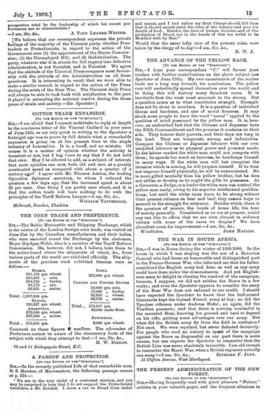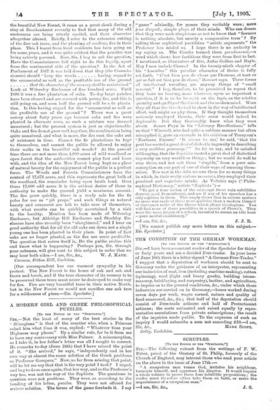the beautiful New Forest, it came as a great shock
during a stay at Brockenhurst recently to find that many of the old enclosures are being utterly spoiled, and their character altogether altered. Briefly, I refer to the extensive cutting of the fine oak trees, and the planting of seedling firs in their place. This I learnt from local residents has been going on for some years, and it was quite evident that the practice was being actively pursued. Now, Sir, I beg to ask the question, Have the Commissioners full right to do this legally, apart from the sentimental side of the question? In the Act of Parliament of 1887 it was laid down that they (the Commis- sioners) should "keep the woods having regard to the ornamental as well as the profitable use of the ground that the character of the scenery shall be maintained." Look at Wilverley Enclosure of five hundred acres. Until 1890 it was a fine plantation of oaks. To-day large patches have been cleared and are covered with young firs, and this is still going on, and soon half the ground will be a fir planta tion. Is this having regard for the "ornamental as well as the profitable use of the ground" P There was a great outcry about forty years ago because oaks and firs were planted in alternate rows, as such a mixture was deemed unnatural ; but the present system is just as objectionable. Oaks and firs do not grow well together, the combination being quite unnatural, and what is more, the firs oust the oaks out of existence in time. Cannot the fir plantations be kepi: to themselves, and cannot the public be allowed to enjoy their walks in the beautiful oak woods ? At the present time there are not more than 4,800 acres of wild woodland or open forest that the authorities cannot play fast and loose with, and the idea of the New Forest being kept as a place of natural beauty for the enjoyment of the public is a perfect farce. The Woods and Forests Commissioners have the control of 17,671 acres, and this represents the great bulk of the woodland, the remainder being open heath land. Over these 17,000 odd acres it is the evident desire of those in authority to make the ground yield a maximum amount. The firs grow quickly, there is a ready sale for the fir poles for use as "pit props," and such things as natural beauty and ornament are left to take care of themselves, with what results can be quickly ascertained by a visit to the locality. Mention has been made of Wilverley Enclosure, but Aldridge Hill Enclosure and Stockley En- closure have also recently been "slaughtered," and I hear on good authority that for all the old oaks cut down not a single young one has been planted in their place. In point of fact oaks are no longer planted, as the firs are more profitable. The question that raises itself is, Do the public realise this and know what is happening ? Perhaps you, Sir, through your columns, will give vent to this subject in order that we [Our correspondent has our warmest sympathy in his protest. The New Forest is the home of oak and ash and thorn and beech, and if the true character of its scenery is to be preserved these trees must never be destroyed to make way for firs. Firs are very beautiful trees in their native North, but in the New Forest we would not sacrifice one oak tree for a wilderness of pines.—ED. Spectator.]











































 Previous page
Previous page